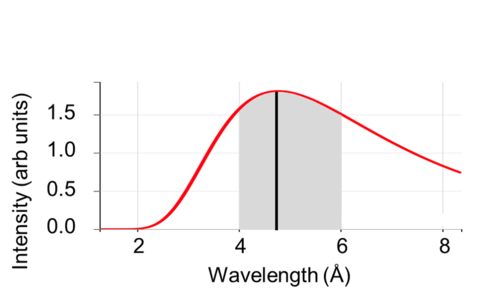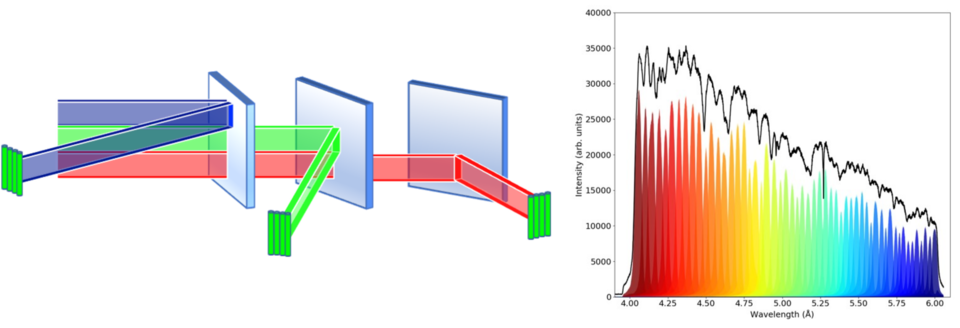CHRNS CANDOR - White-Beam Reflectometer
The CHNRS Chromatic Analysis Neutron Diffractometer or Reflectometer (CANDOR) instrument is a cold white beam neutron reflectometer used to study surface and interface science across a wide range of disciplines including quantum materials, magnetic multilayers, polymer films, battery heterostructures, and biological membranes. CANDOR is primarily used for specular neutron reflectometry, a technique sensitive to the depth profiles of the nuclear composition and the vector magnetization in thin films and multilayers. CANDOR offers significant advantages over traditional monochromated neutron reflectometers at reactor sources. Rather than using an extremely narrow wavelength band, as illustrated by the vertical red line in the image below, CANDOR simultaneously collects data utilizing a continuous range of neutron wavelenths from 4 Å - 6 Å. Thanks to this design, CANDOR has realized a of 20× - 30× gain factor relative to previous designs while reducing the relative noise floor. This greatly increases instrument sensitivity and enables measurements previously expected to take a week of beamtime to be done in a matter of hours.
The CHRNS CANDOR instrument is able to interpret a reflected beam with a broad wavelength dispersion thanks to the unique design of the detector arrays. Each array consists of 54 pyrolytic graphite monochromators arranges at different angles relative to the propagation direction of the reflected beam. As the beam passes through each monochromator, a relatively narrow wavelength window is diffracted into one of the 54 individual thin film neutron detectors in the side-wall of the array. As shown below, the CANDOR detector array can therefore reproduce the tight resolution function of a traditional reactor-source reflectometer while utilizing a continuous wavelength band from 4 Å - 6 Å. CANDOR currently employs 2 detector arrays, with the instrument designed to support expansion to a maximum of 26 arrays, installed in the scattering plane to increase intensity or simultaneously measure background.
Specifications/Capabilities
Instrument:
- Q resolution, dQ/Q, ~0.025
- Fractional wavelength resolution ~0.015
- Angular resolution ranging from 1 to 10 minutes (of arc)
- 25× intensity gains over traditional reactor reflectometer designs
- Low-background - 8 orders of magnitude dynamic range for unpolarized measurements, 6-7 for polarized beam.
Sample Environment:
- Polarized beam w/ electromagnet support fields up to 700 mT
- Temperature range 2.5 K - 315 K standard (higher potentially available in special cases)
- Electric fields up to 2 kV
- In-situ electrical transport measurements
- liquid cells with automated syringe pumps
Scientific Opportunities/Applications
The CHRNS CANDOR reflectometer has recently entered the NCNR user program with 50% normal time allocated! Users are encouraged to contact instrument scientists about measurements and submit proposals in the next call.
Typical Material Systems
- Quantum, topological, and magnetic materials
- Batteries and energy materials
- Biological membranes
- Polymer films
Measurement Types
- Thin film reflectivity
- Thin film diffraction
- Measurements of structural evolution in real time




